Republic of Turkey and Ottoman Empire
May, 2012
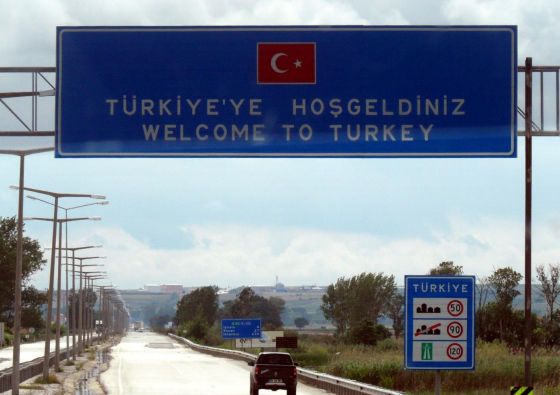
We were greeted by new tour guides, who helped us to move into another bus after crossing the border from Greece. A Turkish tour guide who spoke some Koreans was in charge of our tour program, but the actual guiding work was done by a Korean guide, who outlined our six-day agenda for touring the eastern half of Turkey.
We were scheduled to visit Troy, Ephesus, Pamukkale, Cappadocia, and Istanbul, and though it would normally take two weeks to cover such a wide area. Our tour guide warned us our schedules would be tight. He said we’d get wake-up calls at six in the morning, eat a quick breakfast, and be on our way before eight. We’d be also walking long distances. History of Turkey since Ottoman When we crossed the border into Turkey, I could hear echoes of the Ottoman Empire, a multinational, multilingual Turkish kingdom that lasted from 1299 to 1923, one of the largest and longest lasting empires in history. Our tour guide provided us with many stories of its politics, conflicts, and the cultural heritage in a vast geographical area.
The empire was one of the most powerful in the world during the sixteenth and seventeenth centuries, when Suleiman the Magnificent was at the height of his power. I couldn’t stop comparing Ottoman with the Chosun Dynasty (1392-1910) in the Korean peninsula. The Ottoman Empire attacked the neighboring areas some 700 times, while the Chosun Kingdom was attacked mainly by Japanese pirates and other countries almost the same number times.
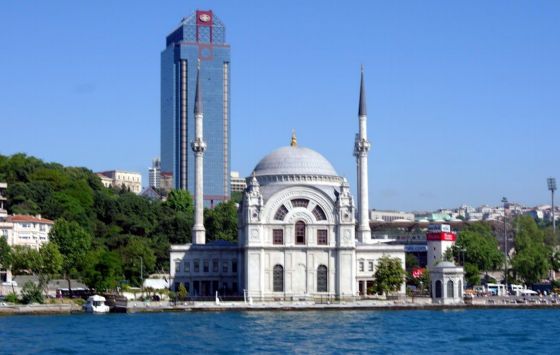
A wave of nationalism swept through many countries during the nineteenth century and greatly affected territories within the Ottoman Empire. A burgeoning national consciousness, together with a growing sense of ethnic nationalism, made nationalistic thought one of the most significant Western ideas imported into the Ottoman Empire. It was forced to deal with nationalism both within and beyond its borders.
The number of revolutionary political parties rose dramatically, and uprisings in Ottoman territory had far-reaching consequences in the nineteenth century and determined much of Ottoman policy during the early 20th century. The rise of nationalism didn’t help Koreans, since Japanese took over the peninsula in 1910.
By 1914, the Ottoman Empire was suffering after a series of Balkan wars. The empire had been driven out of Europe, and North Africa, though it still controlled some 23 million people, including17 million Turks, 3 million Syrian, Lebanese and Palestinians, and 2.5 million Iraqis. Another 5.5 million people on the Arabian Peninsula were also under nominal Ottoman rule.
In many ways, the circumstances surrounding the Ottoman Empire's fall closely paralleled those of the Roman Empire, particularly the ongoing tensions between the empire's various ethnic groups, and the government’s inability to deal with those tensions. The introduction of increased cultural rights, civil liberties, and a parliamentary system came too late to reverse the nationalistic and secessionist trends that had already been set into motion in the early nineteenth century.
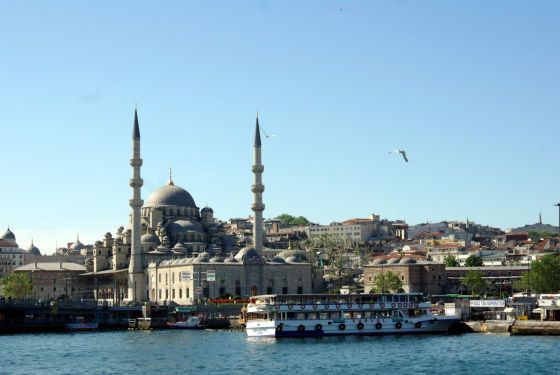
The life in the Ottoman Empire was a mixture of Western and Eastern lifestyle, making life fragmented mosaic of many different cultures. The capital of the Ottoman Empire, Constantinople, also had a unique culture, mainly because it had been the seat of both the Roman and Byzantine Empires before Ottoman rule.
As Turkey transformed from the religion-based former Ottoman Empire into a modern nation with a strong separation of state and religion, an increase in artistic expression evolved. During the first years of the republic, the government invested a large amount of its resources into the fine arts such as museums, theatres, opera houses, and architecture. Diverse historical factors played important roles in defining the modern Turkish identity. Turkish culture is a product of an effort to be a "modern" Western state, while maintaining its traditional religious and historical values.
The single party system in Turkey ended in 1945. It was followed by a tumultuous transition to multiparty democracy over the next few decades, interrupted by military coups d’état in 1960, 1971, 1980, and 1997. Since the liberalization of the Turkish economy in the 1980s, the country has enjoyed stronger economic growth and greater political stability.
We crossed the Aegean Sea by ferry to Canakkale, Turkey, Asia’s extreme. The eastern part is the Korean Peninsula. Some Korean political leaders used this geographical situation as the reason for calling Korea and Turkey “brother countries.”
After a bumpy ride over rough highways, we stayed our first night in a seaside hotel near the ancient site of Troy. The hotel and area were so beautiful that I asked my friends to think about just staying there during the future vacation.
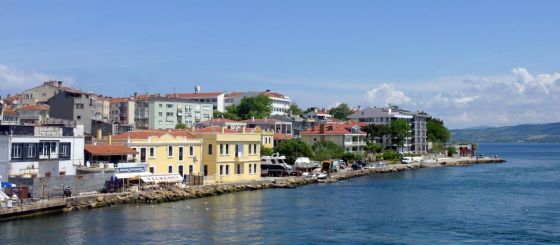
Troy
Troy was a city in northwest Anatolia, but best known as the setting of the Trojan War described in the Greek Epic Cycle (and especially in The Iliad, one of two epic poems attributed to Homer). A new city called Ilium was founded on the site during the reign of Roman Emperor Augustus. It flourished until the establishment of Constantinople and gradually declined during the Byzantine era.
The region’s history goes way back 3,000 years, when the Trojan War was waged against the city of Troy by the Achaeans after a prince of Troy took Helen from her husband Menelaus, king of Sparta. The Iliad describes part of the last year of the siege of Troy, and The Odyssey describes Odysseus' journey home.
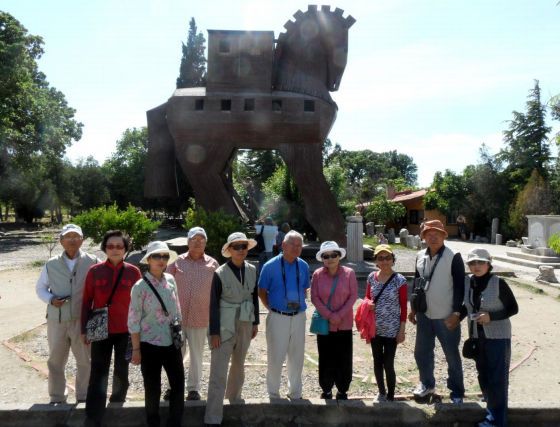
I watched the movie version of the Trojan War and read a translation of The Iliad, in which the Achaeans set up camp near the mouth of the River Scamander and anchored their ships. The city of Troy stood on a hill, across the plain of Scamander, where the battles of the Trojan War took place. The site of the ancient city is some three miles from the coast today, but the river poured into a large bay that formed a natural harbor 3,000 years ago. It has since been filled with alluvial material. Recent geological findings have permitted the reconstruction of the original Trojan coastline, and the results largely confirm the accuracy of the Homer’s of Troy.
Besides The Iliad, there are references to Troy in The Odyssey and other Greek literature. The Homeric legend of Troy was elaborated on by the Roman poet Virgil in his Aeneid. The Greeks and Romans took the Trojan War and the existence of Troy as historical fact. Alexander the Great, for example, visited the site in 334 B.C. and made sacrifices at tombs associated with Achilles and Patroclus.
With the rise of modern history, Troy and the Trojan War were consigned to the realms of legend. However, the exact location of ancient Troy had always been a subject of speculation, until 1822, when Scottish journalist Charles Maclaren identified the location of the acropolis of Augustus' New Ilium in north-western Anatolia.

Ephesus
Ephesus was an ancient Greek city, then, a major Roman city, and is now a Turkish city on the west coast of Asia Minor. In the first century B.C., it had a population of some 250,000, making it one of the largest cities in the Mediterranean world.
Ephesus also was one of the seven churches of Asia, cited in the biblical book of Revelation. The Gospel of John may also have been written there. The city was the site of several fifth century Christian councils. The house where the Virgin Mary spent her last days and where died in the presence of Saint John was near Ephesus.
Koreans tourists visit the area as a Christian holy place with an easy access from the port of Kusadasi. I met a few young Korean couples with their school-age children in a Korean restaurant and asked how they could take a vacation during the middle of May. They all seemed surprised and told me that touring Ephesus was more important for their children than school works. I had never considered taking a vacation with our children when school was in session, but I had to nod my head to show that I agreed with them.
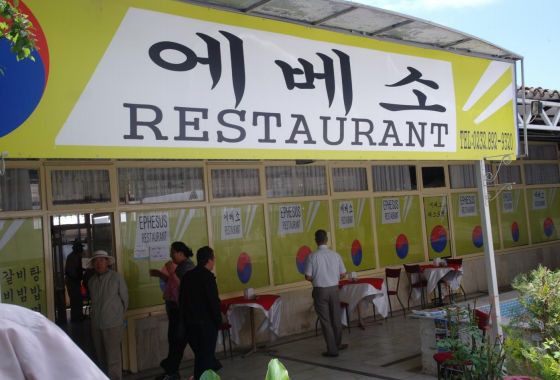
Turkish style Korean food with its fresh red peppers and hot sauce wasn’t my favorite, but it was much better than the Greek or Turkish dishes we had been eating on our tour. 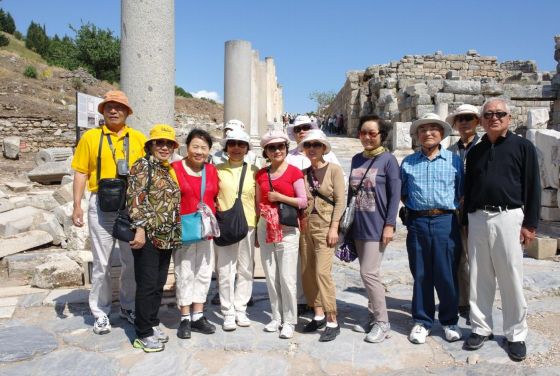
We took a guided tour of Ephesus, the site of the largest collection of Roman ruins in the eastern Mediterranean—and only 15% has been excavated. The ruins that are visible give some idea of the city's original splendor, and the names associated with the ruins are evocative of its former glory. A theater dominates the view down Harbor Street, which leads to the ancient harbor. The Celsus Library stands tall, reflecting the ancient grandeur of Ephesus, as shown on the back of Turkish 20 TL bill.
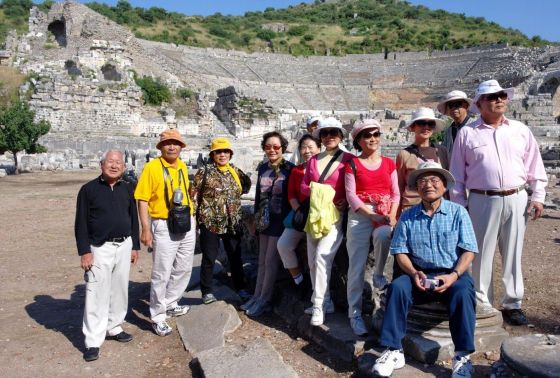
I was amazed to see baths of Varius and Scholastikia, built in the firt century. Scholastikia baths had four rooms: cold, lukewarm, hot, and sweating just like Roman baths, and the whole interiors were laid with natural marbles. There also were dressing room, resting room, a library and a gymnasium. The bath could serve a thousand people.
Mr. Kim, our tour guide had come to Turkey about thirteen years earlier to study the art history of the region. He worked part-time as a tour guide, but his main job was collecting and selling arts. His revelations and emotional interpretations of the historical site were excellent.
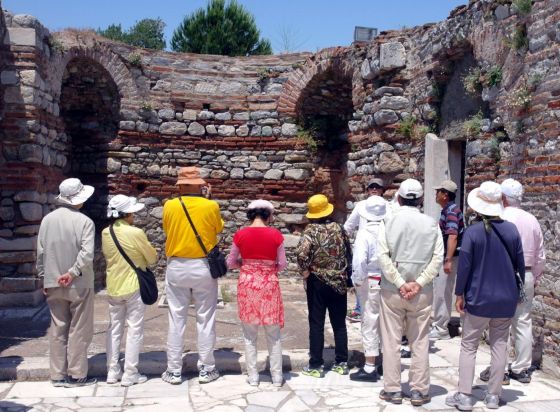
Construction of the Library of Celsus began in 125 A.D. in memory of Julius Celsus Polemaeanus, governor of Roman Asia (105–107), who paid for the construction with his own wealth, and was buried in a sarcophagus beneath it. The library, however, was mostly built by his son--and once held nearly 12,000 scrolls. Designed with an exaggerated entrance to enhance its size the building faced east so its reading rooms could make the best use of the morning light.
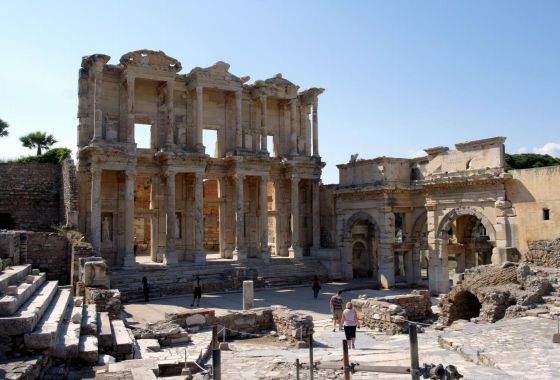
Saint John came to Ephesus in 42 A.D. with the Virgin Mary and lived and died in the city after spreading the message of Christianity. Saint Paul, who came to the city in 52 A.D, formed a Christian society and stayed there for three years. Some Christians among our group were touched when they stood in front of Saint John tomb, and prayed.
A church with a wooden roof was built on the site in the fourth century with a monument indicating the location of Saint John’s grave. Emperor Justinian, later, built a basilica with the tomb of Saint John was beneath a dome in the middle.
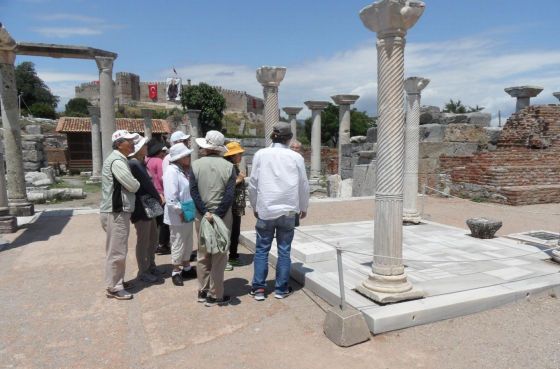
After walking many miles around the ancient city, we drove to Kuşadasi, a resort town on Turkey's Aegean coast and a center of art and culture since the founding Leleges people in 3,000 B.C. Later settlers included the Aeolians in the eleventh century B.C. and the Ionians in the ninth century B.C. From the window of our luxurious hotel, we had glorious view of the Kusadasi harbor.

Pamukkale and Hierapolis
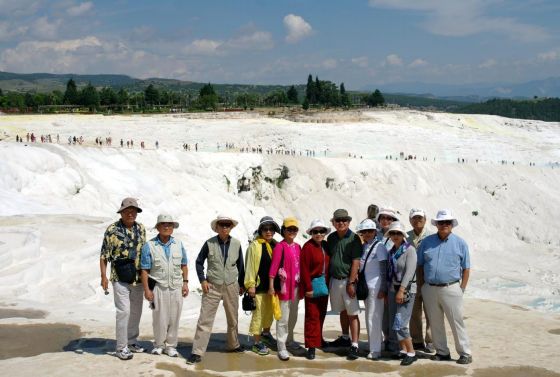
Pamukkale [cotton castle] in Turkey's Inner Aegean region is a site of natural hot springs and travertine, terraces of carbonate minerals left by the flowing water.
The ancient Greco-Roman and Byzantine city of Hierapolis was built on top of the white "castle," which is about 8,860 ft. long, 1,970 ft. wide, and 525 ft. high. It can be seen from the hills on the opposite side of the valley in the town of Denizli. This huge city was built to be used as a resort for kings, queens, generals and dignitaries.
Our tour guide added a personal side as we viewed the site, “I’m so glad I wasn’t born in those days,” because more than 10,000 slaves and other poor citizens were exploited during the building of the magnificent city.
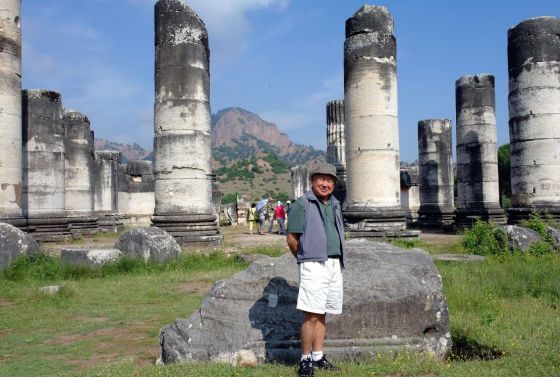
People have bathed in its pools for thousands of years, but as recently as the mid-twentieth century hotels were being built over the ruins of Hierapolis, causing considerable damage to the ancient site. An approach road was built from the valley over the terraces and motor bikes were allowed to go up and down the slopes. When the area was declared a World Heritage site, the hotels were demolished and the road removed.
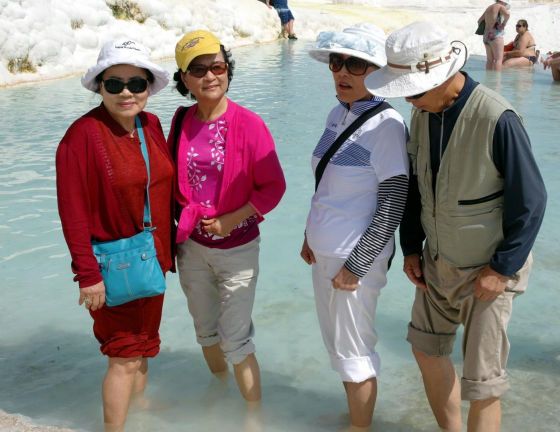
We checked into a hotel under the “castle” and enjoyed swimming in modern hot spring pools, which had Turkish massage facilities. The ladies in our group were tempted to indulge in expensive cosmetic massages. I asked if they had a Japanese version of a “Turkish bath for men,” imported by American soldiers in 1945. They had no idea I was talking about a steam bath, followed by a massage given by nearly naked woman.
In the museum, alongside historical artifacts from Hierapolis, there were artifacts from Laodiceia, Colossae, Tripolis, Attuda, and other towns of the Lycos valley. The artifacts in open exhibition space are mostly made of marble and stone. The museum’s exhibition space consisted of three closed areas of the Hierapolis bath and open areas on the eastern side, which was known to have been used as a library and gymnasium.
The underground volcanic activity that causes the hot springs also forces carbon dioxide into a cave, which was called the Plutonium (home of the god Pluto). The cave was used for religious purposes by priests of Cybele, who were apparently immune to the suffocating gas.
Cappadocia
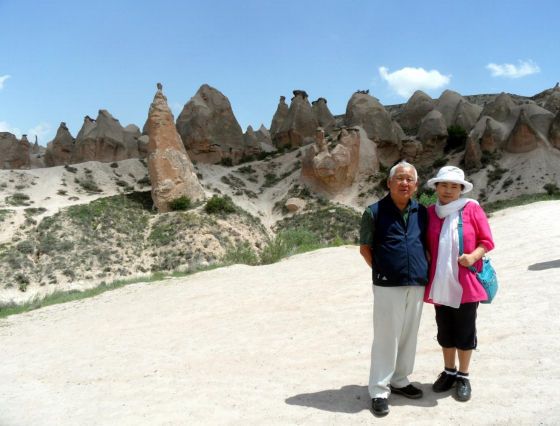
Cappadocia is a historical region in Central Anatolia. The Cappadocians were believed to occupy the whole region, from Mount Taurus to the vicinity of the Black Sea.
We were overwhelmed by the natural wonders of the underground cities, which were used by early Christians as hiding places before Christianity became an accepted religion.
The underground cities included vast defense networks spread throughout many levels. Those defenses were very creative, including large round stones to block doors and holes in ceilings through which defenders could drop spears. The tunnel system consisted of thin corridors that made it impossible for groups Romans to move in.
Istanbul
Istanbul is Turkey’s largest city, with a population of 13.4 millions, and lies on the Bosphorus Strait, extending onto the European and Asian sides. Istanbul is the only city in the world situated on two continents.
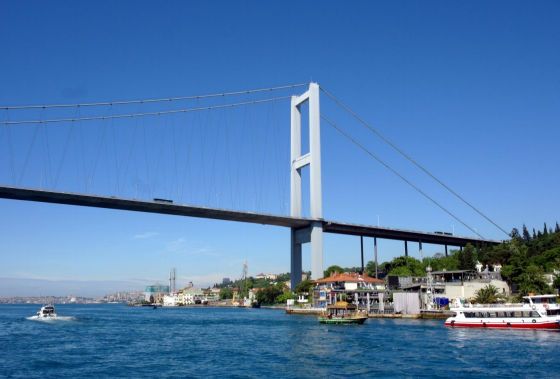
During its long history, Istanbul has served as the capital of the Roman Empire, the Byzantine Empire, the Latin Empire, and the Ottoman Empire. When the Republic of Turkey was established in 1923, Ankara was chosen as its capital.
Constantinople began to decline after the Fourth Crusade, during which it was sacked and pillaged. The city subsequently became the center of the Latin Empire, created by Catholic crusaders to replace the Orthodox Byzantine Empire, which had divided into splinter states. However, the Latin Empire was short-lived, and the Byzantine Empire was restored, in 1261. Constantinople's churches, defenses, and basic services were in disrepair, and its population had dwindled to 40,000 from nearly half a million in the ninth century.
Following the fall of Constantinople, Mehmed II immediately set out to revitalize the city, now known as Istanbul. First he deported all the Christian population, leaving only the Jewish inhabitants of Balat. Then he forcibly resettled many Muslims, Jews, and Christians from other parts of Anatolia and Rumelia into the city, creating a cosmopolitan society that persisted throughout much of the Ottoman period.

Istanbul's strategic position along the historic Silk Road, rail networks to Europe and the Middle East, and the only sea route between the Black Sea and the Mediterranean have helped foster an eclectic populace, although less so since the establishment of Turkish Republic.
Overlooked for the new capital during much of the twentieth century, the city has regained much of its prominence. The city’s population increased tenfold since the 1950s, as migrants from across Anatolia flocked to the metropolis.
Commuter ferries have been operating on the Bosphorus since 1851 and are the primary mode of public transportation between the European and Asian halves of the city. We toured the Bosphorus Strait and the beautiful city of Istanbul by a boat.
Hagia Sophia is a former Orthodox basilica which later was converted into a mosque, and is now a museum in Istanbul. The church was dedicated to the Logos, of the Holy Trinity. Although it’s sometimes referred to as the Church of Saint Sophia, sophia is a phonetic Latin spelling of the Greek word for wisdom.
Famous for its massive dome, it’s considered the epitome of Byzantine architecture, and is said to have "changed the history of architecture." It was the largest cathedral in the world for nearly a thousand years, until Spain’s Seville Cathedral was completed in 1520.

In 1453, Constantinople was conquered by the Ottoman Turks, who ordered the building converted into a mosque. The bells, altar, and sacrificial vessels were removed and many of the church’s mosaics were plastered over. Four minarets were added, and the building remained a mosque until 1931. It was closed to the public for four years and then re-opened as a museum in 1935.
The Topkapi Palace was the primary residence of the Ottoman sultans for approximately 400 years of their 624-year reign. As well as a royal residence, the palace was the setting for state occasions and royal entertainments. It’s now a major tourist attraction containing important holy relics of the Muslim world, including the Prophet Muhammad's cloak and sword.
The palace complex consists of four main courtyards and many smaller buildings. At its peak, the palace was home to as many as 4,000 people. The complex was expanded over the centuries to contain mosques, a hospital, bakeries, and a mint. The name translates as "Cannon Gate Palace," referring to nearby gate that was long ago destroyed.
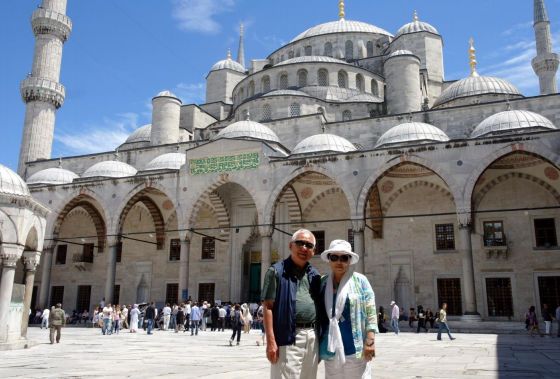
The Topkapi Palace gradually lost importance as sultans began to spend more time in their new palaces along the Bosporus.
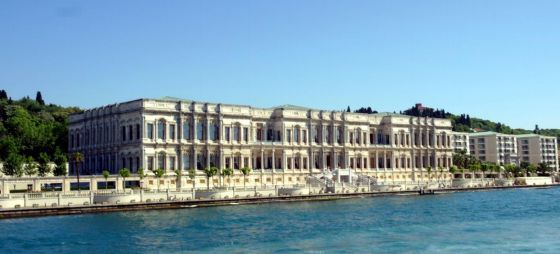
With the end of the Ottoman Empire in 1921, the palace was transformed into a museum of the imperial era. The palace complex has hundreds of rooms, but only the most important are accessible to the public. The museum includes large collections of porcelain, robes, weapons, shields, and armor as well as a display of Ottoman treasures and jewelry.
Our tour plan of Istanbul included shopping, and we were escorted through the grand bazaar in Istanbul, which is the oldest and largest shopping center of the world with its sixty-four streets and roads, two covered bazaars, sixteen inns, and about 3,600 shops. Our guide emphasized that all prices in the various shops were negotiable—sometimes down to as much as 50% of the original asking price. The complex looked just like the old South Gate Market in Seoul, although prices aren’t negotiable.
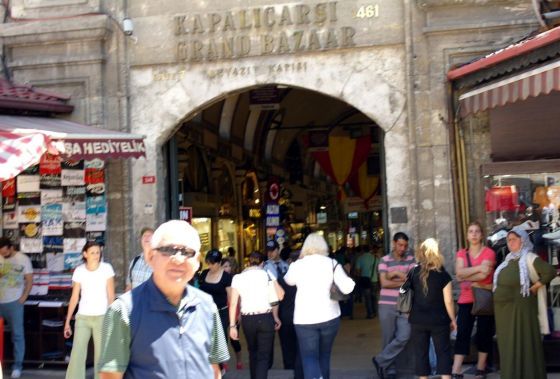 Picture and story by Wonho Chang - May, 2012 |































Üsküdar'a gider iken
Üsküdar'a gider iken aldi da bir yagmur (When going to Üsküdar, rain started)
Katibimin setresi uzun etegi çamur (My scribes’ coats are long, his skirt is muddy)
Katip uykudan uyanmis gözleri mahmur (The scribe has woken up from sleep, his eyes are cloudy)
Katibime kolali da gömlek ne güzel yarasir (The scribe is mine, and im the scribes, hands will mix)
Katibime kolali da gömlek ne güzel yarasir (How much it suits my scribe to have a starched collar)
Üsküdar’a gider iken bir mendil buldum (On the way to Üsküdar I found a kerchief)
Mendilimin içine lokum doldurdum (And I filled the kerchief with lokum (Turkish delight candy))
Ben yarimi arar iken yanimda buldum (When I looked for my helper, I found him at my side.)
Katip benim ben katibin el ne karisir (The scribe is mine and I'm the scribes and hands will mix)
Katibime kolali da gömlek ne güzel yarasir (How much it suits my scribe to have a starched collar)
Üsküdar is a little town in Ýstanbul, Turkey,
long the shore of the Bosphorus...
And in the old days, many women, especially those of upper classes,
had young, male secretaries and attendants... Oh, well, that's Turkey!
The fine, Istanbullite lady and her secretary take a trip from Üsküdar in the rain...
And on the way they fall deeply in love.
He's wearing a stiff collar... In a full dress suit...
She looks at him longingly through her light veil
And casually feeds him candy -turkish delight-
Oh, those Turks!